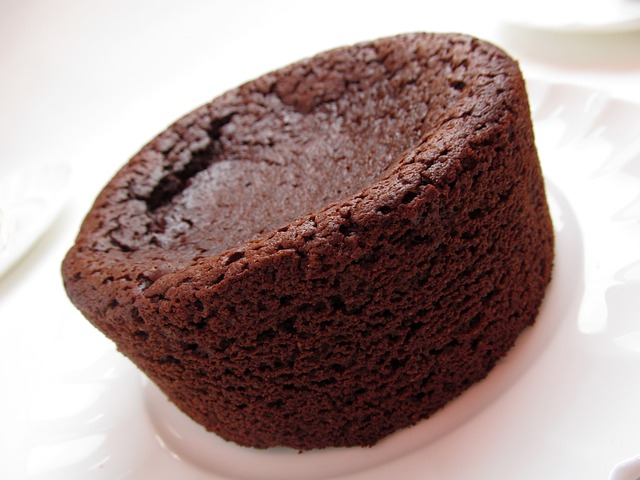
A cake is often tasted with pleasure and fond memories, leaving us with joy. Why then, when we bring a freshly baked cake to the table, does it collapse?
Why do cakes fall when cooling?
Cakes fall when cooling if they are over-baked. This can be attributed to the unbalanced moisture content in the batter, which causes poor structural integrity during the cooling period.
The baking process involves a number of complex chemical reactions that lead to coagulation and denaturation of proteins, starch gelatinization, and caramelization of sugar.
The chemical reactions cause the batter to expand initially by incorporating more air (carbon dioxide), then later by forming steam.
The latter is very important for the internal structure of the cake, as it helps to set the porous structure that provides strength and stability.
This steam formation occurs when the cake is baking in a hot oven, but it also continues a little after the cake is removed from the oven.
If the cake batter contains a large amount of butter and eggs, then steam formation is less effective at dissipating heat from within the cake, and this ‘cooks’ the cake more than is desirable.
This results in a poor quality of internal structure, which is less able to absorb or dissipate the stresses that occur during cooling.
The cake is, therefore, more susceptible to collapse due to the differential shrinkage that occurs between the cake crumb and the crust.
Cakes that have a high sugar content are more likely to fall since sugar will crystallize as the water within it evaporates.
How do you keep a cake from falling after baking?
The success of a cake depends on the development of a fine, moist crumb with a good volume, as well as an even distribution of ingredients throughout the batter.
The process of baking has to be carefully controlled in order to obtain these characteristics, and this is where the baker’s skill comes in.
After the cake is baked, it should be allowed to cool gradually at room temperature in its pan or on a wire rack for at least 20-30 minutes.
Rapid cooling will cause the cake to shrink and fall, also affecting its flavor and texture.
If the cake is a fruit cake, a common practice is to soak the cake in a liquid immediately after it is removed from the oven.
The liquid can be rum or brandy which adds flavor to the cake, but it also serves as a way to soften the crust and bind any loose crumbs on the surface of the cake.
This practice is also used with pound cakes because it makes them moister.
To keep a cake from falling, do not overbake it.
Cakes should be baked at the minimum required temperature, to yield a fine-grained texture and be safe from collapse.
It is also advisable to under-bake the cake by 5 minutes, then leave it in its pan and place it back in a warm oven to finish baking.
The cake can still be baked without collapsing since the residual heat in the oven will prevent collapse by continuing the chemical reactions that lead to cake formation.
After the cake is taken out of the oven, it should be allowed to cool slowly in its pan at room temperature to avoid collapse due to the sudden release of internal steam.
Cakes that are allowed to cool in their pan will also tend to absorb any condensation on the sides of the pan, which adds to its richness and flavor.
A final test used to determine if a cake is cooked enough is to insert a wooden toothpick into the center of the cake.
If it comes out clean, then the cake is cooked through and can be removed from the oven, cooled, and served.
If there is batter stuck to the toothpick, then put it back in and let it cook for another 5 minutes.
The toothpick test is only useful with cakes that are uniformly cylindrical, such as pound cake or Bundt cake.
With a layered cake such as a fluted tube pan or chiffon cake, the toothpick test should be used only to determine if the cake is fully baked on the surface.
With a layered cake, insert the toothpick into the center of one layer to check if it is done.
Place the cake pan on a wire rack to cool for 20 minutes, before unmolding and cooling further on the rack.
How to stop cake sinking when cooling?
To stop the cake from sinking when cooling, all you can do is not over-bake it.
And, in this regard, if you under-bake it by 5 minutes, put the cake back in the hot oven, and bake some more for 5 minutes, it will do the job.
If you find yourself in a situation where the cake is sunken in the middle, you can fill it back up with cakes frosting or even fresh fruit.
It’s not much of a problem, most people won’t notice.
To avoid this in the future, simply don’t over-bake your cakes.
There is no fixed time, but after you have baked the cake for the required time, keep checking on it.
If you find that the top of your cake is getting browner than usual before the cake is done, then simply take it out of the oven right away.
Cake baking can be a difficult task, but with these tips and tricks, you should be able to bake the perfect cake every time.
How to fix a sunken cake?
To fix the sunken cake, all you have to do is to level the top using a serrated knife.
If you think your cake is too crumbly, use sour cream as a binder and add to your batter.
If you want a denser cake, add 2 extra egg whites to the recipe and leave out two tablespoons of liquid.
To combat the problem of sunken centers when baking a cheesecake, add 1/2 teaspoon each of baking powder and flour.
If your cake is overbaked, you can try turning it into a bread pudding by cutting the cake into cubes and layering them with vanilla custard sauce.
Make a simple syrup and soak the cake cubes in it. You can add rum or brandy to enhance the flavor of your bread pudding.
If your cake is underbaked, use an ice-cream scoop and fill the holes with vanilla pudding or make a pastry cream and fill it with that.
If your cake is still too moist, you can try letting the pudding set and then spreading it over the cake.
This will help with the cake’s texture.
Final Thoughts
To sum it up, cakes fall when cooling because it is baked too long and/or at too high of a temperature.
When the cake cools and then cools quickly, it can collapse.
You can fix this by making sure to check your cake while it is baking. The toothpick test might not be possible when you have a limited time.
You can also fill in any holes with frosting or fresh fruit and top the cake off with a yummy sauce!
With this simple knowledge, any baker should be able to bake the perfect cake every time.
Thank you for reading “Why do cakes fall when cooling?”
To learn more tips and techniques about foods, visit my related resources here.

